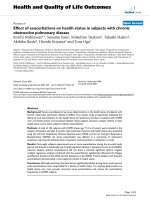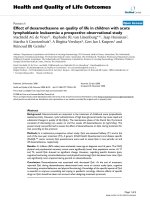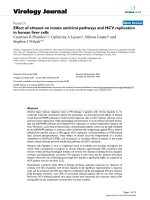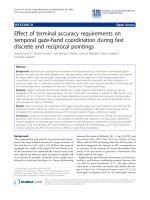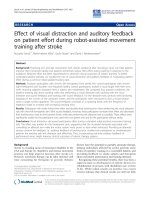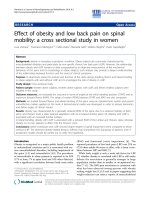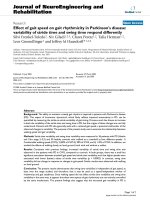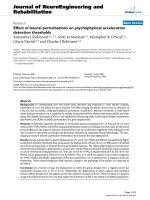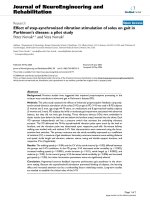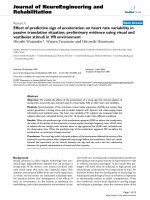báo cáo hóa học:" Effect of borax on immune cell proliferation and sister chromatid exchange in human chromosomes Malinee Pongsavee" docx
Bạn đang xem bản rút gọn của tài liệu. Xem và tải ngay bản đầy đủ của tài liệu tại đây (584.44 KB, 6 trang )
Journal of Occupational Medicine and
Toxicology
Research
Effect of borax on immune cell proliferation and
sister chromatid exchange in human chromosomes
Malinee Pongsavee
Address: Department of Medical Technology, Faculty of Allied Health Sciences, Thammasat University, Rangsit Campus,
Patumthani 12121, Thailand
E-mail:
Published: 30 October 2009 Received: 16 April 2009
Journal of Occupational Medicine and Toxicology 2009, 4:27 doi: 10.1186/1745-6673-4-27
Accepted: 30 October 2009
This article is available from: />© 2009 Pongsavee; licensee BioMed Central Ltd.
This is an Open Access article distributed under the terms of the Creative Commons Attribution License (
s/by/2.0),
which permits unrestricted use, distribution, and reproduction in any medium, provided the original work is properly cited.
Abstract
Background: Boraxisusedasafoodadditive.Itbecomestoxicwhenaccumulatedinthebody.It
causes vomiting, fatigue and renal failure.
Methods: The heparinized blood samples from 40 healthy men were studied for the impact of
borax toxicity on immune cell proliferation (lymphocyte proliferation) and sister chromatid
exchange in human chromosomes. The MTT assay and Sister Chromatid Exchange (SCE) technic
were used in this experiment with the borax concentrations of 0.1, 0.15, 0.2, 0.3 and 0.6 mg/ml.
Results: It showed that the immune cell proliferation (lymphocyte proliferation) was decreased
when the concentrations of b orax increased. The borax concentration of 0.6 mg/ml had the most
effectiveness to the lymphocyte proliferation and had the highest cytotoxicity index (CI). The borax
concentrations of 0 .15, 0.2, 0.3 and 0.6 mg/ ml significantly induced sister chromatid exchang e in
human chromosomes (P < 0.05).
Conclusion: Borax had effects on immune cell proliferation (lymphocyte proliferation) and
induced sister chromatid exchange in human chromosomes. Toxicity of borax may lead to cellular
toxicity and genetic defect in human.
Background
Borax (Na
2
B
4
O
2
(H
2
O)
10
) is a low toxicity mineral with
insecticidal, fungicidal and herbicidal properties. The
basic structure of borax contains chains of interlocking
BO
2
(OH) triangles and BO
3
(OH) tetrahedrons bonded
to chains of sodium and water octahedrons. Borax occurs
naturally in evaporate deposits produced by the repeated
evaporation of seasonal lakes. It is a precursor for
sodium perborate monohydrate that is used in deter-
gents. Borax can be produced synthetically from other
boron compounds. It is usually a white powder
consisting of soft colorless crystals that dissolve easily
in water. Borax is used in detergents and cosmetics, as an
ingredient in enamel glazes, glass, pottery, and ceramics,
to make buffer solutions. It is used mixed with water as
a flux when soldering jewelry metals such as god or
silver [1].
Borax has the toxicity to humans, including reproductive
and developmental toxicity, neurotoxicity, and nephro-
toxicity. The degree of borax toxicity depends on the
dose or concentration that the human received. The most
sensitive endpoints of borax toxicity is developmental
and reproductive toxicity [2]. Borax causes irritation of
skin and respiratory tract. The gastrointestinal tract, skin,
vascular system and brain are the principal organs and
tissues a ffected. It causes nausea, persistant vomiting,
abdominal pain, diarrhea, erythematous and exfoliative
rash, unconsciousness, depression and renal failure.
Brockman et al., 1985 reported about borax toxicity in
Page 1 of 6
(page number not for citation purposes)
BioMed Central
Open Access
animals. Chunks of borax were used to control in the
pH
+
in drilling muds. Catt le consumed these chunks.
They appeared depressed, were dehydrated and some
had diarrhea. In the dead animals, the predominant
lesion was hemorrhagic gastroenterititis [3].
Food additives are substances added to food to preserve
flavor or improve its taste and appearance. Food
additives are one of the causes in many cancer types
[4]. Carrageenan is one of the food additive that involve
in cancer. It is a naturally occurring gum derived from
red seaweed. It is associated with loss of mammary
myoepithelial cells in tissue culture provides a potential
mechanism for increasing invasive mammary carcinoma
[5] and induced colonic neoplasia in animal models [6].
Borax is used as a food additive in some countries with
the E number E285. Although borax has reproductive
toxicity, nephrotoxicity and neurotoxicity in human but
the borax toxicity about human genetic materials and
humoral immune cell still need to be investigated for
food additive carcinog enesis. The defect in genetic
material and immune cell development involves in
human carcinogenesis. In this study, we studied about
the toxic effects of borax on immune cell proliferation
(lymphocyte proliferation) and genotoxicity (sister
chromatid exchange). We studied the toxic effect on
immune cell proliferation by MTT assay and genotoxicity
(cytogenetic level) by Sister Chromatid Exchange t echnic
(SCE technic).
MTT [3-(4,5-dimethyl-2-thiazolyl)-2,5- diphe nyl-2H tet -
razolium bromide] colorimetric assay is a standard
colorimetric assay for measuring cellular growth. It has
been developed by Mosmann. It can also be used to
determine cytotoxicity of toxic materials. Yellow MTT is
reduced to purple formazan in the mitochondria of
living cells. A solubilization solution is added to dissolve
the insoluble purple formazan product into a colored
solution. The absorbance of this colored solution can be
quantified by measuring at a certain wavelength (usually
between 500 and 600 nm.) by a spectrophotometer. The
absorption maximum is dependent on the solvent
employed. This reduction takes place only when
mitochondrial reductase enzymes are active, and there-
fore conversion can be directly r elated to the number of
living cells. When the amount of purple formazan
produced by cells treated with an agent is compared
with the amount of formazan produced by untreated
control cells, the effectiveness of the agent in causing
death of cells can be deduced, through the production of
a dose-response curve [7]. Various technical modifica-
tions for the MTT assay on diffe rent cell lines have done
in many experiments about cancer. The MTT assay can be
used for the chemosensitivity testing of short-term cell
lines derived from human brain tumors [8].
Sister chromatid exchange (SCEs) represent the inter-
change of DNA replication products at apparently
homologous chromosomal loci. These exchanges involve
DNA breakage and reunion. Sister Chromatid Exchange
technic (SCE technic) affords the opportunity for
cytological detection of DNA interchange. This technic
is used as a sensitive means of monitoring DNA damage.
It is useful for assessing the cytogenic impact of
clastogenic agents on chromosomes. It can be performed
in cultured cells (in vitro) or on cells from intact animals
given BrdU (in vivo). Many agents found to induce SCEs
are well-known mutagens and/or carcinogens [9]. The
increased resolution of SCE detection afforded by
fluorescence or Giemsa technic has permitted localiza-
tion of SCEs relative to chromosome-banding patterns.
In human chromosomes, SCEs occur preferentially in
Q-negative bands or at the junction of Q-positive and
Q-negative regions [10]. The toxic effects of borax to
immune cell proliferation and genotoxicity in human
were studied (in vitro) to verify borax toxicity.
Methods
Blood samples
Heparinized blood from 40 consenting healthy male
were collected. The participants were given consent to
donate blood for study in the borax toxicity research.
This study was approved by Thammasat University ethic
committee.
Studying the effect of borax on immune cell
proliferation (lymphocyte proliferation) by
MTT assay
Forty human lymphocyte cultures of forty heparinized
blood samples were cultured in RPMI medium (Gibco
BRL Life Technologies, San Diego, CA, USA) plus 10%
fetal calf serum (Invitrogen, Carlsbad, CA, USA) and
penicillin-streptomycin antibiotic. Phytohemagglutinin
was added in RPMI medium as the mitogen and
incubated for 72 hours. After 72 hours incubation, a
total of 1 × 10
5
cells/well from each lymphocyte culture
were selected in the 24-well plate and incubated for
24 hours.
The borax concentrations of 0.1, 0.15, 0.2, 0.3 and
0.6 mg/ml were tested in this study. These doses were
high as compared to being used as food additive but it is
likely that due to high consumption it may be
accumulative. Forty lymphocyte cultures from forty
blood samples were tested in each borax concentration.
After 24 hours incubation, various concentrations of
borax added to the wells to get the final concentration of
0.1, 0.15, 0.2, 0.3 and 0.6 mg/ml. The cells were
incubated for an additional 24 hours. After 24 hours,
0.5 ml of 300 μg/ml MTT in phosphate buffer saline
Journal of Occupational Medicine and Toxicology 2009, 4:27 />Page 2 of 6
(page number not for citation purposes)
(PBS) were added to each well and incubated for 4 hours
at 37°C. The medium was removed and formazan was
dissolved in DMSO and the optical density was
measured at 570 nm. using a Bio-assay reader. MTT
assay of forty lymphocyte cultures in each borax
concentration was carried out in duplicate fashion.
Mean absorbance was calculate for the control wells
and for each borax concentration in the test wells. The
degree of immune cell proliferation (lymphocyte pro-
liferation) sensitivity to borax toxicity was based on the
cytotoxicity index (CI). The p ercent of cytotoxicity index
(%CI = [1-OD
570
treated/OD
570
control] × 100) was
calculated for each borax concentrati on [11].
Studying the effect of borax on genotoxicity
(sister chromatid exchange in human chromosomes)
by Sister Chromatid Exchange technic
(SCE technic)
Forty human lymphocyte cultures of forty heparinized
blood samples were cultured in RPMI medium (Gibco
BRL Life Technologies, San Diego, CA, USA) plus 1 0%
fetal calf serum (Invitrogen, Carlsbad, CA, USA) and
penicillin-streptomycin antibiotic. Phytohemagglutinin
was added in RPMI medium as the mitogen. One ml of
6 μg/ml BrdU was added in each lymphocyte culture.
The borax solutions, 0.1, 0.15, 0.2, 0.3 and 0.6 mg/ml
were added in forty lymphocyte cultures respectively.
Forty lymphocyte cultures from forty samples were
tested in each borax co ncentration. Af ter 72 hours
incubation, colcemid solution was added 3 0 minutes
prior to the harvest. Metaphase cells were harvested by
centrifugation, treated with 0.075 M KCl and fixed in
methanol: acetic (3:1). Slides were prepared and stained
by the fluorescence plus Giemsa technic [12]. SCEs
from forty lymphocyte cultures in each borax concen-
tration were detected. SCEs were observed under
microscope and scored in forty five metaphases per
sample [13].
Statistical analysis
Statistica l anal ysis for study the toxicity of each borax
concentration on imm une cell proli feration (lymphocyte
proliferation) by MTT assay and stud y about the
genotoxicity effect were done by ANOVA test.
Results
Studying the effect of borax on immune cell
proliferation (lymphocyte proliferation)
The cultures of human lymphocyte were treated with
borax at final concentration of 0.1, 0.15, 0.2, 0.3 and
0.6 mg/ml for 24 hours. The value of mean absorbance
reflected the anti-proliferation of lymphocyte by borax.
Mean absorbance conversion can be directly related to
the number of living lymphocytes. The results indicated
that at the borax concentrations of 0.15, 0.2, 0.3 and
0.6 mg/ml, lymphocytes showed low proliferation as
compared to that of control group and 0.1 mg/ml borax
concentration (Figure 1). The numbers of living lym-
phocytes were decreased when the borax concentrations
increased (Figures 2, 3). The proliferation of lympho-
cytes was inhibited by borax. The 0.15 mg/ml borax
concentration was the minimum borax concentration
which was toxic for immune cell proliferation ( lympho-
cyte proliferation). T he different borax concentrations
for standardization (0.1 - 0.6 mg/ml) were used in this
study. Any doses between 0.1 mg/ml to 0.6 mg/ml borax
concentrations gave comparable results and the cyto-
toxicity index (CI) was calculated for each borax
concentration. The borax concentration of 0.6 mg/ml
had the most effectiveness to the lymphocyte prolifera-
tion and had the highest cytotoxicity index (CI) in this
study (Figure 4). The 50% inhibitory concentration
(IC
50
) was 0.9 mg/ml (unpublished data). The results
indicated the correlation between the immune cell
proliferation and the borax cytotoxicity.
Studying the effect of borax on genotoxicity (sister
chromatid exchange in human chromosomes)
Damage to genetic materials can be cytologically
observed as SCE. The induction of SCE suggests exposure
to genotoxins and possibly carcinogens. The increasing
of SCE frequencies (mean SCE ± SD) when c ompared
between the 0.1 mg/ml borax concentration
Figure 1
The correlation between measured absorbance
(mean ± SD) and the various borax concentrations by
MTT assay. Mean absorbance related to the numbers of
living lymphocytes. The lymphocyte proliferation was
decreased when the borax concen tration in creased. Borax
effects on immune cell proliferation (lymphocyte
proliferation).
Journal of Occupational Medicine and Toxicology 2009, 4:27 />Page 3 of 6
(page number not for citation purposes)
experimental subgroup and the control group was not
significant (P > 0 .05). The increasing of SCE frequencies
(mean SCE ± SD) when compared between the 0.15 mg/
ml borax concentration experimenta l subgroup and the
control group was significant (P < 0.05). This study also
found the significant increases in the SCE fr equencie s
(mean SCE ± S D) of human chromosomes in each of the
three experimental subgroups (the borax concentration
of 0.2, 0.3 and 0.6 mg/ml experimental subgroups)
when compared to the control group (P <0.05)(Table1).
The mean SCE ± SD in the experimental subgroups was
increased when the borax concentration increased. The
borax concentrations of 0.15, 0.2, 0.3 and 0.6 mg/ml
significantly induced sister chromatid exchange in
human chromosomes (P < 0.05) (Table 1). The borax
concentrations of 0.15, 0.2, 0.3 and 0.6 mg/ml had the
genotoxic effect to human chromosomes. When the
human chromosomes exposed to borax, SCE occurrence
in human chromosomes was increased in the borax
concentrations of 0.15, 0.2, 0.3 and 0.6 mg/ml experi-
mental subgroups comparing with the control group.
Figure 5 showed the sister chromatid exchange occur-
rence in human chromosomes of the control group.
Figures 6A, B showed the sister chromatid exchange
occurrence in human chromosomes of the 0.15 and
0.6 mg/ml borax concentration experimental subgroups.
Discussion
Borax is the chemical substance which is toxic to human
andanimal.Inhuman,boraxistoxictocellsandhasa
slow excretion rate through the kidney. Kidney toxicity is
Figure 2
Lymphocyte proliferationinthecontrolgroup.The
black arrows indicated many living lymphocytes in this group.
Figure 3
Lymphocyte proliferation in the 0.2 mg/ml borax
concentration experimental subgroup.Theblack
arrows indicated the dead lymphocytes in this subgroup.
Borax effects on lymphocyte proliferati on.
Figure 4
The correlation between the cytotoxicity index (CI)
and the borax concentr ations. It showed that t he borax
concentration of 0.6 mg/ml had the most cytotoxic
effectiveness on immune cell proliferation (lymphocyte
proliferation).
Table 1: Comparison of SCE frequencies in the control group and
the experimental group
Group Mean SCE ± SD P-value
The control group 0.74 ± 0.07
The experimental group
Borax 0.1 mg/ml experimental subgroup 2.20 ± 0.10 > 0.05*
Borax 0.15 mg/ml experimental subgroup 2.63 ± 0.11 < 0.05 *
Borax 0.2 mg/ml experimental subgroup 3.17 ± 0.14 < 0.05 *
Borax 0.3 mg/ml experimental subgroup 3.69 ± 0.18 < 0.05 *
Borax 0.6 mg/ml experimental subgroup 5.31 ± 0.19 < 0.05 *
* The statistical analysis comparing between the control group and each
experimental subgroup.
Journal of Occupational Medicine and Toxicology 2009, 4:27 />Page 4 of 6
(page number not for citation purposes)
the greatest, with liver fatty degenerations, cerebral
edema and gastroenteritis. In animal, the testicular
effects of borax were observed in rat, mouse and dog
[14]. In rats, a single dose of 175 mg borax/kg bw was
found to cause reversible disruption of tubular spermia-
tion [15]. There were the reports about borax toxicity
that it cau sed testicular atrophy, degeneration of
seminiferous tubules, reduced sperm count, r eduction
in fertility in rats [16] and reduced fertility [17]. For the
developmental toxicity of borax, t he foetal body weight
was de creased [18], minor skeleton variation with the
exception of short rib XIII in rats [19].
In this study, the results from MTT assay indicated that at
the borax concentrations of 0.15, 0.2, 0.3 and 0. 6 mg/ml,
immune cell proliferation (lymphocyte proliferation)
showed low proliferation as compare d to that of control
group (Figures 1, 2, 3, 4). The numbers of viable
lymphocyte were decreased in lymphocyte culture
treated with high dose of borax. The 0.6 mg/ml borax
concentration had the most effectiveness to lymphocyte
proliferation in this study. It was toxic for cellular
proliferation. Borax effects lymphocyte proliferation and
it may cause cytotoxicity in immune cell (lymphocyte).
SCE frequencies have been examined in many human
diseases such as Bl oom syndrome. A variety of chemical
and physical agents exhibiting diverse modes of interac-
tion with DNA. These agents are capable of inducing
SCE. The SCE technique is a sensitive means of
monitoring DNA damage. The borax concentrations of
0.15, 0.2, 0.3 and 0.6 mg/ml induced sister chromatid
exchange in human chromosomes (P < 0.05) (Table 1,
Figures 5, 6). The frequency of SCE was incre ased when
the borax concentration increased. The SCE frequencies
of human chromosomes increased significantly in the
experimental group as compared with the control group,
suggesting that borax may have genotoxic effect in
human.
Conclusion
Borax i s used as a food additive in some countries. This
study suggests that borax may effect on immune cell
(lymphocyte) cytotoxicity and genetic damage. The
consumer should be careful about eating the preserved
food for their health.
Competing interests
The author declares that they have no competing
interests.
Acknowledgements
I would like t o thank Thammasat University for the research grant to
support this research.
Figure 5
SCE in the control group. The black arrow indicated SCE
in human chromosome.
Figure 6
SCE frequencies in the 0.15 mg/ml (6A), 0.6 mg/ml
(6B) borax concentration experimental subgroups.
The black arrows indicated SCEs occur red among h uman
chromosomes of these subgroups. The s ister chromatid
exchange occurrence increasedintheboraxconcentrations
of 0.15, 0.2, 0.3 a nd 0.6 mg/ml exp erimental subgr oups
comparing with the control gro up.
Journal of Occupational Medicine and Toxicology 2009, 4:27 />Page 5 of 6
(page number not for citation purposes)
References
1. National Coa lition Against the Mis-Use of Pesticides (NCAMP):
“Least Toxic Pesticides-Borates”. Washington DC 2001.
2. Murray FJ: A Human Health Risk Assessment of Boron (Boric
Aci d and Borax) in Drinking Water. Regul T oxicol Pharmacol
1995, 22:221–230.
3. Brockman R P, Audette RJ and Gray M: Borax Toxicity. Can Vet J
1985, 147.
4. Sugimura T: Food and cancer. Toxicology 2002, 181-182:17–21.
5. Tobacman JK : Filament disassembly and loss of mammary
myoepithelial cells aft er exposure to lamda-carrageenan.
Cancer Res 1997, 57:2823–2826.
6. Marcus SN, Marcus AJ, Marcus R, Ewen SWB and Watt J: The pre-
ulcerative phase of carrageenan-induced colonic ulceration
in the guinea pig. Int J Exp Pathol 1992, 73:515–526.
7. Mosmann T: Rapid colorimetric assay for cellular growth and
survival: Applicatio n to proliferation and cytotoxicity assays.
J Immunol Meth 1983, 65:55–63.
8. Nikkhah G, Tonn JC, Hoffmann O, Kraemer HP, Darling JL,
Schonma yr R and Schache nmayr W: The MTT assay for
chemosensitivity testing of huma n tumors of the central
nervous system. J N eurooncol 1992, 13:1–11.
9. Lat t SA and Schreck RR: Sister chromatid exchange analysis.
Am J Hum Genet 1980, 32:297–313.
10. Crossen PE, Drets ME, Arrighi FE and Johnston DA: Analysis of the
frequency and distribution of s ister chromatid exchange in
cultured human lymphocytes. Hum Genet 1977, 35:345–352.
11. Hand CM, Vender JR and Black P: Chemotherapy in experi-
mental brain tumor, part 1: in vitro colorimetric MTT assay.
J Neurooncol 1988, 36:1–6.
12. Perry P and Wolff S: New giems a method for the differential
staining of sister chromatids. Nature 1974, 251:156–158.
13. Tummalapalli P, Ramana DC and Reddy P: Analys is of sister
chr omatid exchanges in mint factory workers. Rev Biomed
2003, 14:11–15 .
14. NTP. National Toxicology Program. Technical Report Series No.324:
Toxicology an d carcinogenesis st udies of b oric acid (CAS
10043-35-3) in B6C3F1 mice.US Department of Health and
Human Services, National Institute of Health; 1987.
15. Linder RE, Strader LF and Rehnberg GL: Effect of acute exposur e
to boric acid on the male reproductive system of the rat. J
Toxicol Environ Health 1990, 31:133–146.
16. Weir RJ and Fisher RS: Toxicologic studies on borax and boric
acid. ToxicolApplPharmacol1972, 23:351–364.
17. Fail PA, George JD, Seely J C, Grizzle TB and Heindel JJ:
Reproductive toxicity of boric acid in Swiss (CD-1) mice:
assessment using the con tinuous breeding protocol. Fund
Appl Toxicol 1991, 17:225–239.
18. Price CJ, Field EA, Marr MC, Myers CB, Morrissey RE and
Schwetz BA: Final report on the development toxicity of
boric acid (CAS No 10043-35-3) in Sprague Dawley rats.
NIEHS/NTP (NTP-90-105/NTP-90-105A) (and report supplement),
Order No.PB91-137570 1990.
19. Pri ce CJ, Strong PL, Marr MC, Myers CB and Murray FJ: Develop-
mental toxicity NOAEL and postnatal recovery in ra ts fed
boric acid during gestation. Fund Appl Toxicol 1996, 32:179– 193.
Publish with BioMed Central and every
scientist can read your work free of charge
"BioMed Central will be the most significant development for
disseminating the results of biomedical research in our lifetime."
Sir Paul Nurse, Cancer Research UK
Your research papers will be:
available free of charge to the entire biomedical community
peer reviewed and published immediately upon acceptance
cited in PubMed and archived on PubMed Central
yours — you keep the copyright
Submit your manuscript here:
/>BioMedcentral
Journal of Occupational Medicine and Toxicology 2009, 4:27 />Page 6 of 6
(page number not for citation purposes)
